大学英语教案经典模板文库
大学英语教案模板全英文

大学英语教案模板全英文大学英语教案模板全英文篇一:大学英语教案经典模板教案Practical College English新认知大学实用英语综合教程教研室:公共课部教师姓名:freefishwang大学英语教案模板全英文篇二:大学英语教案范本全新版《大学英语》教案课程名称:大学英语(一级)专业:本校05普通本科年级:2005学年:2005-2006学期:第一学期任课教师:全新版《大学英语》板块任课教师Course ScheduleAims:1. Developing Ss’ability of independent learning to be automatic learners.2. Enhancing Ss’ability in using English: improving Ss’five micro-skills—listening,speaking, reading, writing, translation —especially listening andspeaking so that they can communicate in spoken and written English.Required course materials:1. College English (Book 1)—Integrated Curse, Listening and Speaking Course, Reading CourseNote: Reading Course book is used as Ss’self-access material. 2. One Dictionary:Teaching and Learning:1. Keep in mind that it is YOU who have to study to improve your English. If you do not studyby yourself, there is no use in coming to class. In other words, just listening to the teacher and other students in class does not help you improve your English.2. Be well prepared when you come to class. It is of great importance for you to preview thecourse materials before class according to the course schedule. If not, you’ll find it very difficult to follow the class.3. Class participation is vital. You should actively join in pair work or group discussion and dooral presentation before class.4. It is important to turn in any assignments by the due date. Ifyou know that you have acircumstance which will makes it impossible for you to turn in your assignment by the due date, you can and should come to consult with me about your problem beforehand.5. Your essays should be done in a loose-leaf notebook so as to hand in your assignments by aloose paper.6. Since attendance/absence is part of evaluation, keep in mind that your absence will reduceyour evaluation.Useful English Learning Resources:Magazines: English Language Learning, College English, English Salon, English Weekly, The world of English, English Digest, Overseas EnglishNewspaper: 21st Century, China DailyWebsites: (英语比萨园地); (听力快车); (普特英语听力); (英文写作网); (旺旺英语); .cn (中国日报);(华盛顿邮报)Unit 1 Writing For Myself1. 教学目标及基本要求:Objectives:Students will be able to:1) grasp the main idea (the essence of writing is to write what one enjoys writing) and structure of the text (narration in chronological sequence);2) appreciate the narrative skills demonstrated in the text (selection of details, repetition and the use of synonyms.)3) master the key language points and grammatical structures in the text;4) conduct a series of reading, listening, speaking and writing activities related to the theme of the unit.2. 教学内容及学时分配:Time allotment:1st period: pre-reading; text organizationnd2 period: while-reading3 period: post-reading activities4 period: reading practice5th period: speaking6 period: writing3. 教学重点及难点:Important language points in the text:4. 教学内容的深化及拓宽:ththrdStudents conduct a series of reading, listening, speaking and writing practice to deepen their understanding of the points taughtin class.5. 教学方式及在教学中应注意的问题:A combination of traditional teaching methods with the communicative approach will be adopted. Special attention should be paid to classroom interaction. Give students time to adapt to the new teaching mode in the university that are quite different from the one they were used to in the middle school. More encouragement is needed and more guidance will be given to them in their extracurricular study.6. 主要参考书目:季佩英,吴晓真,2001,《全新版大学英语综合教程1-教师用书》。
大学英语优秀教案模板

1. 知识目标:- 掌握本单元的核心词汇和短语。
- 理解并分析文章的结构和逻辑。
- 学习并运用相关的语法知识。
2. 能力目标:- 提高阅读理解能力,能够准确把握文章的主旨和细节。
- 增强英语写作能力,能够撰写结构清晰、逻辑严谨的短文。
- 提升听说能力,能够进行基本的英语口语交流。
3. 情感目标:- 激发学生对英语学习的兴趣,培养良好的学习习惯。
- 增强学生的自信心,提高面对英语挑战的勇气。
二、教学内容1. 基本内容:- 精读课文,了解文章的主旨和细节。
- 学习并掌握本单元的核心词汇和短语。
- 分析文章的结构和逻辑,提高阅读理解能力。
2. 重点:- 关键词汇和短语的理解与应用。
- 文章结构的分析。
3. 难点:- 语法知识的运用。
- 阅读理解中的逻辑推理。
1. 导入(10分钟):- 利用图片、视频等多媒体手段,激发学生的学习兴趣。
- 通过简单的提问,引导学生回顾上一节课的内容。
2. 课文精读(30分钟):- 学生自主阅读课文,完成相关练习。
- 教师讲解课文中的重点词汇和短语,并进行语法知识讲解。
- 针对课文中的难点,进行详细讲解和分析。
3. 课堂讨论(20分钟):- 学生分组讨论课文内容,分享自己的观点。
- 教师引导学生进行逻辑推理,提高阅读理解能力。
4. 写作练习(20分钟):- 学生根据课文内容,进行写作练习。
- 教师点评学生的写作,并提供修改建议。
5. 课堂小结(10分钟):- 教师总结本节课的重点内容。
- 学生回顾本节课所学,并提出疑问。
四、教学评价1. 课堂表现:- 学生参与课堂活动的积极性。
- 学生回答问题的准确性。
2. 作业完成情况:- 学生完成作业的质量。
- 学生对作业内容的掌握程度。
3. 写作能力:- 学生写作文的结构和逻辑。
- 学生对词汇和短语的运用。
4. 听说能力:- 学生在课堂讨论中的表现。
- 学生在口语练习中的流利程度。
五、教学反思1. 教师在教学过程中,要关注学生的学习情况,及时调整教学策略。
大学英语优秀教案50篇
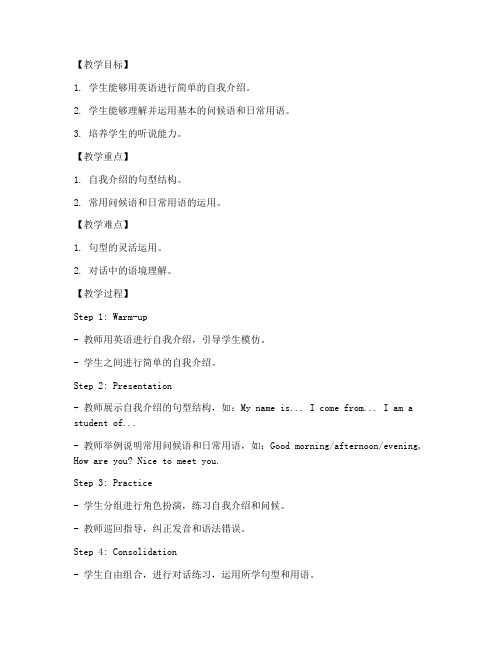
【教学目标】1. 学生能够用英语进行简单的自我介绍。
2. 学生能够理解并运用基本的问候语和日常用语。
3. 培养学生的听说能力。
【教学重点】1. 自我介绍的句型结构。
2. 常用问候语和日常用语的运用。
【教学难点】1. 句型的灵活运用。
2. 对话中的语境理解。
【教学过程】Step 1: Warm-up- 教师用英语进行自我介绍,引导学生模仿。
- 学生之间进行简单的自我介绍。
Step 2: Presentation- 教师展示自我介绍的句型结构,如:My name is... I come from... I am a student of...- 教师举例说明常用问候语和日常用语,如:Good morning/afternoon/evening, How are you? Nice to meet you.Step 3: Practice- 学生分组进行角色扮演,练习自我介绍和问候。
- 教师巡回指导,纠正发音和语法错误。
Step 4: Consolidation- 学生自由组合,进行对话练习,运用所学句型和用语。
- 教师选取优秀对话进行展示,给予点评。
Step 5: Homework- 学生回家后,用英语写一篇简短的自我介绍。
- 课后复习常用问候语和日常用语。
教案二:Unit 2 Daily Life【教学目标】1. 学生能够用英语描述日常生活。
2. 学生能够理解并运用与日常生活相关的词汇和句型。
3. 培养学生的听力和口语能力。
【教学重点】1. 描述日常生活的句型结构。
2. 与日常生活相关的词汇和句型。
【教学难点】1. 句型的灵活运用。
2. 对话中的语境理解。
【教学过程】Step 1: Warm-up- 教师提问学生关于日常生活的常见话题,如:What do you usually do in the morning? What is your favorite food?- 学生回答问题,复习相关词汇。
大学英语教学备课教案模板
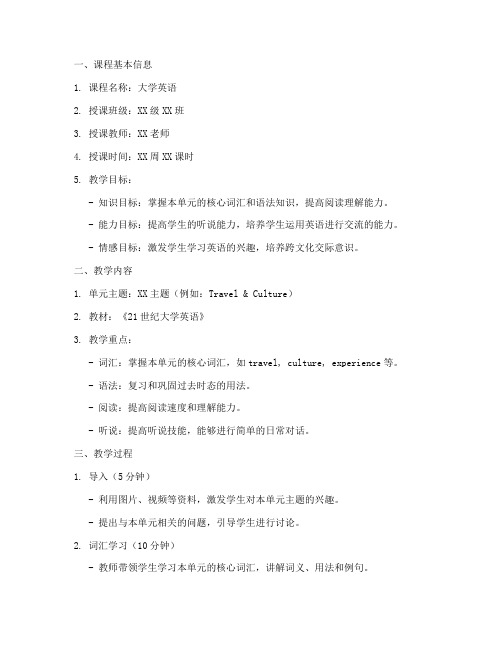
一、课程基本信息1. 课程名称:大学英语2. 授课班级:XX级XX班3. 授课教师:XX老师4. 授课时间:XX周XX课时5. 教学目标:- 知识目标:掌握本单元的核心词汇和语法知识,提高阅读理解能力。
- 能力目标:提高学生的听说能力,培养学生运用英语进行交流的能力。
- 情感目标:激发学生学习英语的兴趣,培养跨文化交际意识。
二、教学内容1. 单元主题:XX主题(例如:Travel & Culture)2. 教材:《21世纪大学英语》3. 教学重点:- 词汇:掌握本单元的核心词汇,如travel, culture, experience等。
- 语法:复习和巩固过去时态的用法。
- 阅读:提高阅读速度和理解能力。
- 听说:提高听说技能,能够进行简单的日常对话。
三、教学过程1. 导入(5分钟)- 利用图片、视频等资料,激发学生对本单元主题的兴趣。
- 提出与本单元相关的问题,引导学生进行讨论。
2. 词汇学习(10分钟)- 教师带领学生学习本单元的核心词汇,讲解词义、用法和例句。
- 学生通过小组活动,运用所学词汇进行造句。
3. 语法讲解(10分钟)- 教师讲解过去时态的用法,并通过例句进行巩固。
- 学生进行语法练习,巩固所学知识。
4. 阅读理解(15分钟)- 学生阅读课文,完成课后练习题。
- 教师对练习题进行讲解,帮助学生理解课文内容。
5. 听说训练(15分钟)- 学生进行小组讨论,运用所学词汇和语法进行对话。
- 教师进行点评和指导。
6. 课堂小结(5分钟)- 教师对本节课的内容进行总结,强调重点和难点。
- 学生进行自我评价,反思自己的学习情况。
四、课后作业1. 完成课后练习题。
2. 复习本单元的词汇和语法知识。
3. 预习下一单元的内容。
五、教学反思1. 教师在教学过程中,要注意激发学生的学习兴趣,引导学生积极参与课堂活动。
2. 教师要根据学生的实际情况,调整教学进度和教学方法。
3. 教师要注重培养学生的听说能力,提高学生的英语交际能力。
大学英语教案模板

大学英语教案经典模板一、课程信息1. 课程名称:大学英语2. 课程目标:提高学生的英语听、说、读、写综合能力,使他们能够熟练运用英语进行日常交流和学术研究。
3. 课程时数:45分钟4. 教学对象:大一学生5. 教学大纲:根据《大学英语》教材的要求,涵盖词汇、语法、听力、口语、阅读和写作等教学内容。
二、教学内容1. 教学主题:介绍大学生活2. 教学重点:学习描述日常生活和学术环境的词汇和表达方式3. 教学难点:正确运用一般现在时描述经常发生的动作或存在的状态4. 教学资源:教材、多媒体课件、黑板三、教学过程1. 热身活动(5分钟)1.1 学生自由交谈,谈论他们的大学生活。
1.2 教师提问,引导学生谈论他们对大学生活的看法和经历。
2. 新课导入(10分钟)2.1 教师介绍一般现在时的概念和用法。
2.2 通过示例和练习,让学生掌握一般现在时的构成和用法。
3. 课堂活动(15分钟)3.1 分组活动:学生分组,每组选择一个主题(如家庭、学校、兴趣爱好等),用一般现在时描述。
3.2 学生展示:每组轮流上台展示他们的描述,其他学生倾听并给予反馈。
4. 巩固练习(5分钟)4.1 学生完成课后练习题,巩固一般现在时的用法。
4.2 教师批改练习,给予学生个别辅导。
四、课后作业1. 完成课后练习题,巩固本节课所学内容。
2. 写一篇短文,描述自己的日常生活和学术环境,尽量使用一般现在时。
五、教学反思1. 教师在课后对自己的教学进行反思,总结教学中的优点和不足。
2. 根据学生的课堂表现和作业完成情况,调整教学方法和策略,以提高教学效果。
3. 针对学生的学习需求,制定下一步的教学计划,确保学生能够掌握英语听、说、读、写综合能力。
六、教学评估1. 课堂参与度:观察学生在课堂活动中的参与程度,了解他们对一般现在时的掌握情况。
2. 作业完成情况:批改学生的课后作业,评估他们对一般现在时的运用能力和写作水平。
3. 小组讨论:评估学生在小组讨论中的表现,了解他们能否主动运用英语进行交流和表达。
大学英语完整的教案

大学英语完整的教案【篇一:大学英语教案经典模板】教案practical college english新认知大学实用英语综合教程教研室:公共课部教师姓名:freefishwang【篇二:大学英语教案模板】unit 8 book 1 experiencing englishi. teaching objectives1. skills:1) reading: reading between the lines2) writing: how to use punctuations in a sentence3) listening: understanding the passages about love and friendship, listening for the main idea and the important details, learning to take notes while listening4) speaking: talking about love and friendship2. vocabulary development:w, depart, enclose, endure, identical, intense, occupy, provoke, standing, trim,2) expressions: compare… to, drift apart, ever after, even if/ though, join hands (with), no matter what/ how, etc., succeed in, try on, go by, in case, pass away, work out3. grammar and structure:1) adverbial clause2) attributive clause3) modal auxiliaries in subjunctive moodii. important points:leave nothing to chance, compare to, even if/ though, no matter how/ what, go by, work out, recognize as/ by, compare with/ toiii. difficult points:1.distinguishing replace, substitute, take the place of; confront, encounter, meet; bear, endure, put up with, stand, suffer, tolerate; acknowledge, admit, confess, recognize2. speaking: talking about love and friendship3. listening: understanding the passages, listening for the main idea and the important details, learning to take notes while listeningiv. teaching arrangements:1. total class time for this unit: 8 periods2. suggested arrangement:1) talking:(duty report, group discussion, free talk etc.) 402) pre-reading activities: 15-203) understanding the structure of text a: 15-204) detailed study of the language:1005) writing skills: 156) text summary 10’7) exercises: 558) reading skills: 15-259) detailed study of of text b: 60-7010) comprehensive exercises: 20iv. lecture scripts:(by the teachers)【篇三:新视野大学英语读写2(第三版)完整教案】新视野大学英语读写教程(第三版)book 2 教案。
大学英语完整的教案

大学英语完整的教案【篇一:大学英语教案经典模板】教案practical college english新认知大学实用英语综合教程教研室:公共课部教师姓名:freefishwang【篇二:大学英语教案模板】unit 8 book 1 experiencing englishi. teaching objectives1. skills:1) reading: reading between the lines2) writing: how to use punctuations in a sentence3) listening: understanding the passages about love and friendship, listening for the main idea and the important details, learning to take notes while listening4) speaking: talking about love and friendship2. vocabulary development:w, depart, enclose, endure, identical, intense, occupy, provoke, standing, trim,2) expressions: compare… to, drift apart, ever after, even if/ though, join hands (with), no matter what/ how, etc., succeed in, try on, go by, in case, pass away, work out3. grammar and structure:1) adverbial clause2) attributive clause3) modal auxiliaries in subjunctive moodii. important points:leave nothing to chance, compare to, even if/ though, no matter how/ what, go by, work out, recognize as/ by, compare with/ toiii. difficult points:1.distinguishing replace, substitute, take the place of; confront, encounter, meet; bear, endure, put up with, stand, suffer, tolerate; acknowledge, admit, confess, recognize2. speaking: talking about love and friendship3. listening: understanding the passages, listening for the main idea and the important details, learning to take notes while listeningiv. teaching arrangements:1. total class time for this unit: 8 periods2. suggested arrangement:1) talking:(duty report, group discussion, free talk etc.) 402) pre-reading activities: 15-203) understanding the structure of text a: 15-204) detailed study of the language:1005) writing skills: 156) text summary 10’7) exercises: 558) reading skills: 15-259) detailed study of of text b: 60-7010) comprehensive exercises: 20iv. lecture scripts:(by the teachers)【篇三:新视野大学英语读写2(第三版)完整教案】新视野大学英语读写教程(第三版)book 2 教案。
大学英语教案范文

大学英语教案范文大学英语教案范文篇一:大学英语教案模板天津大学仁爱学院英语教学部教案20 11 -20 12 学年第二学期授课部门:英语教学部授课教师:Young大学英语教案范文篇二:大学英语教案授课教师:钟雪珂授课时间:2014年3月29日全天、3月30日全天授课科目:新英语(第1册)一、授课内容及目标(一)授课内容1. 自我介绍和日常生活中常见英语标识2. 教材内容:主要包括三个方面的内容。
第一,教材中Unit1、6、7、9的课文内容;第二,相关单元的语法点,主要包括人称代词及其相关形式(主格、宾格、形容词性物主代词、名词性物主代词、反身代词)、动词过去式、被动形式;第三,写作,主要介绍中英文书信格式的差异。
(二)目标:通过授课,让学生熟悉相关单元的知识点(单词、短语、句型和语法点)。
此外,让学生了解中英文书信格式的差异,熟悉几种书信类型的常用表达。
二、教学重点和难点(一)重点:教材中相关单元的知识点1. 单词:Unit1中的introduce/tip/enter/confident/contact/nickname/host/enjoy;Unit 6中的problem/difficulty/order/experience/restaurant/pleasant;Unit7中的purpose/aim/consideration/simply/complete/suit/bargain;Unit 9中的tip/ waiter/ barber/ wage/ earn/ decent/ absolute/ vary/ customs。
2. 短语和句型:Unit1 中的introduce oneself/ have…in common/ lead to/ have a good time/ It is +形容词+ to do sth.;Unit 6 中的have difficulty in doing sth./ask for/have a holiday; Unit 7中的go shopping/ in advance/ be based on/ make up one’s mind/ try on/face with;Unit 9 中的make up/ earn a living。
大学英语教案模板全英文版(10篇)

大学英语教案模板全英文版(优秀10篇)英语(英语:English)是一种西日耳曼语支,最早被中世纪的英国使用,并因其广阔的殖民地而成为世界使用面积最广的语言。
下面是我辛苦为朋友们带来的10篇《大学英语教案模板全英文版》,希望可以启发、帮助到大朋友、小朋友们。
标准英语教案篇五英语教案篇八一。
教学资料《新课程标准小学英语》book7 leon5 how do you usually go to school?二。
学生分析六年级的学生大胆且自立,好奇心重求知欲强,并且爱表现自我。
在经过一段时光的师生磨合和配合之后,进入第五课学习时,学生们就基本熟悉了教师的课堂英语。
爱玩是孩子的天性,六年级的学生不喜欢机械重复乏味的课堂,他们喜欢在游戏中学习,所以在教学过程中我采用了情景教学和游戏教学的模式,让学生们积极主动地参与到英语学习中。
六年级的学生注意力能够集中的时光比较短,借助多媒体手段等激励方式,使学生集中注意力在学习上。
六年级的学生喜欢自我表现,采用小组合作的方式完成情景教学,使学生体味团队协作取得成功的喜悦,增强他们学习英语的自信心。
三。
教学目标1、知识目标a.使学生能熟记bus,car,train,on foot新词汇b.使学生能熟记用句子how do you usually go to school?i usually go to school by…?进行对话2、本事目标使学生能把学到的知识运用到实际生活中去3、情感目标培养学生的自我表达本事和团队合作精神四。
教学重点与难点1、熟记所学新单词,做到发音准确,拼写正确2、能过把新单词运用到句型i usually go to school by……?五。
教学方法情景教学法与游戏教学法相结合六。
学习方法自主学习与小组合作相结合七。
课前准备单词卡片、短语卡片、幻灯片等八。
教学过程1、新课导入首先全班同学起立合唱leon3中的歌曲where do you e from?吸引学生注意力到课堂学习中,同时营造一个良好的英语学习氛围,为新课学习做准备。
大学英语教案模板范文.doc

大学英语教案模板范文【篇一:大学英语教案模板】天津大学仁爱学院英语教学部教案20 11 -20 12 学年第二学期授课部门:英语教学部授课教师:young【篇二:大学英语教案模板】unit 8 book 1 experiencing english i. teachingobjectives1. skills:1) reading: reading between the lines2) writing: how to use punctuations in a sentence3) listening: understanding the passages about love and friendship, listening for the main idea and the important details, learning to take notes while listening4) speaking: talking about love and friendship2. vocabulary development:1) words: acquaintance, barely, encounter, incline, intimate, occasional, principle, recall, recognize, replace, summarize,upset, bow, depart, enclose, endure, identical, intense, occupy, provoke, standing, trim,2) exp ressions: compare ⋯to, drift apart, ever after, even if/ though, join hands (with), no matter what/ how, etc., succeedin, try on, go by, in case, pass away, work out3. grammar and structure:1) adverbial clause 2)attributive clause3) modal auxiliaries in subjunctive moodii. important points:iii. difficult points:1.distinguishing replace, substitute, take the place of;confront, encounter, meet; bear, endure, put up with, stand,suffer, tolerate; acknowledge, admit, confess, recognize2. speaking: talking about love and friendship3. listening: understanding the passages, listening for themain idea and the important details, learning to take noteswhile listeningiv. teaching arrangements:1. total class time for this unit: 8 periods2. suggested arrangement:1) talking:(duty report, group discussion, free talk etc.) 402) pre-reading activities: 15-203) understanding the structure of text a: 15-204) detailed study of the language:1005) writing skills: 156) text summary 10 ’ 7)exercises: 558) reading skills: 15-259) detailed study of of text b: 60-7010) comprehensive exercises: 20iv. lecture scripts:(by the teachers)【篇三:大学英语friendship 教案模板】teaching plan for friendship -all the cabbie had was a letter班级:2 英语13-1姓名:梁欢学号:201341908105 teaching aimsand demands :1. get more background information on the article.2. learning knowledge about the type of the writing and thestructure .3. the comprehension of the text .4. the mastery of the vocabulary and the language points .5. the familiarization with the language and the writingtechniques .teaching content :1. learning all the cabbie had was a letter .2. keys to the meaning of friendship .3.listening comprehension. important points :1.analysis of the structure of the text.2.students can read and understand the article, in the processof reading to consolidate and improve the students readingskills and the ability to extract important information.3.the cultivation of students effective reading skimming andreading skills and strategies. difficult points: 1.the difficultiesare letting the students grasp the type of writing feature article .2.identifying figures of speech .3.paraphrasing some complex sentences .4. translating some sentences .6.employing sentences variety for special effects . teaching period: period 1-2i.warm-up questions / activities listen to the recording two or three times and then think over the following questions:1. have you ever heard of dionne warwick? have you happened to hear her sing?2. what does a fair weather friend mean?3. what does dionne warwick think friends are for?4. does the song give you any idea of what the stories in this unit will be about?ii.teaching schedule. step 1lead-in listening task1. listening practice - here is a story about two friends. listen carefully and see what it reveals .2. after listening - complete the following statements according to what you have heard . step 2 reading taskread the article and skim for the main idea of this article .part one (1-20) from a conversation with the cab driver the author learned how much he regretted failing to keep up corre- spondence with his old friends ed .part two (21-35) reading the letter by himself , the author learned more about the lifelong friendship between the driver and old ed .part three (30) the drivers experience urged the author to reach for his pen .step 3 detailed reading1.pair work-one of you ask the questions and the other answers.2.do the exercises and then compare your answers with a partner .3.read aloud paragraphs 6 to 15 until you have learned then by heart. then try to complete the passage from memory .4.think of these questions . what does a cabbie do?who wrote the letter to the cabbie?why was all the cabbie had only a letter?5.read the last sentence and try to guess what the story isabout.6.summarize the story with three sentences?period 3-4iii useful expressions1.be lost in / lose oneself in: be absorbed in; be fully occupied with .2.or something: used when you are not very sure about what you have just said . 3.go ahead: continue; begin (sometimes followed by with + n.)4.estimate: vt. form a judgment about (a quantity or value)n. approximate calculation or judgment made about a quantity orvalue.5.might / may (just) as well: if you say that you might / may(just) as well do sth., you mean that you will do it although youdo not have a strong desire to do it and may even feel slightlyreluctant about it.6.not much of: not a good ⋯7.keep up: continue without stopping .iv summaryfrom a conversation with the cab driver the author learnedhow much he regretted failing to keep up corre-spondencewith his old friends ed .reading the letter by himself , the author learned more aboutthe lifelong friendship between the driver and old ed .thedrivers experience urged the author to reach for his pen .v homeworkwrite a letter to one of your friend . vi .feedback。
大学英语万能教案
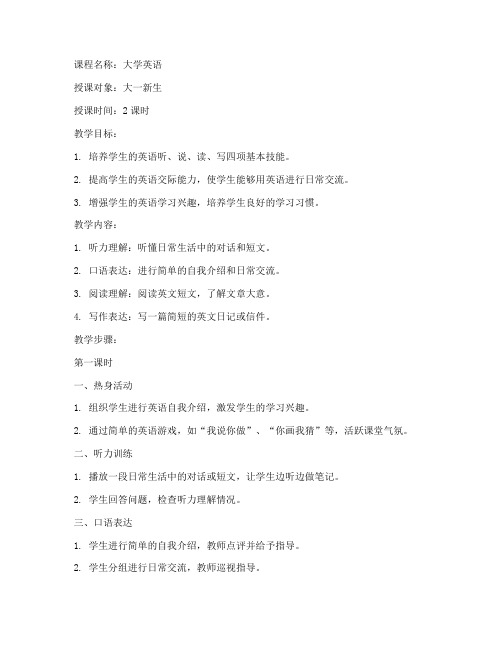
课程名称:大学英语授课对象:大一新生授课时间:2课时教学目标:1. 培养学生的英语听、说、读、写四项基本技能。
2. 提高学生的英语交际能力,使学生能够用英语进行日常交流。
3. 增强学生的英语学习兴趣,培养学生良好的学习习惯。
教学内容:1. 听力理解:听懂日常生活中的对话和短文。
2. 口语表达:进行简单的自我介绍和日常交流。
3. 阅读理解:阅读英文短文,了解文章大意。
4. 写作表达:写一篇简短的英文日记或信件。
教学步骤:第一课时一、热身活动1. 组织学生进行英语自我介绍,激发学生的学习兴趣。
2. 通过简单的英语游戏,如“我说你做”、“你画我猜”等,活跃课堂气氛。
二、听力训练1. 播放一段日常生活中的对话或短文,让学生边听边做笔记。
2. 学生回答问题,检查听力理解情况。
三、口语表达1. 学生进行简单的自我介绍,教师点评并给予指导。
2. 学生分组进行日常交流,教师巡视指导。
四、阅读理解1. 学生阅读一篇英文短文,教师提问,检查阅读理解情况。
2. 学生分享阅读心得,教师点评。
第二课时一、复习上节课内容1. 复习上节课的听力、口语、阅读和写作内容。
2. 学生进行自我检测,教师点评。
二、写作训练1. 学生根据所学内容,写一篇简短的英文日记或信件。
2. 学生互相交换作文,进行互评。
3. 教师点评学生作文,指出优点和不足。
三、课堂总结1. 教师总结本节课的学习内容,强调重点。
2. 学生分享学习心得,提出疑问。
四、课后作业1. 复习本节课所学内容,加强记忆。
2. 完成课后作业,巩固所学知识。
教学评价:1. 课堂表现:观察学生的课堂参与度、口语表达能力、阅读理解能力等。
2. 作业完成情况:检查学生的课后作业,了解学生的学习效果。
3. 学生反馈:收集学生对本节课的意见和建议,不断改进教学方法。
教学资源:1. 英语教材2. 听力材料3. 口语练习材料4. 阅读材料5. 写作范文教学反思:1. 根据学生的学习情况和课堂表现,及时调整教学内容和教学方法。
大学英文教案设计万能模板
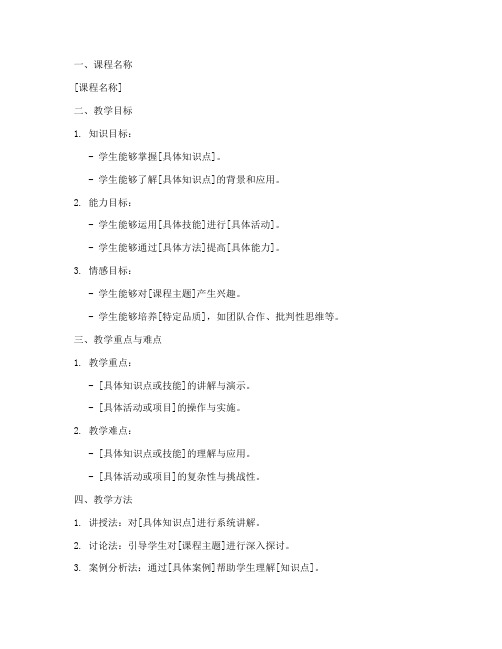
一、课程名称[课程名称]二、教学目标1. 知识目标:- 学生能够掌握[具体知识点]。
- 学生能够了解[具体知识点]的背景和应用。
2. 能力目标:- 学生能够运用[具体技能]进行[具体活动]。
- 学生能够通过[具体方法]提高[具体能力]。
3. 情感目标:- 学生能够对[课程主题]产生兴趣。
- 学生能够培养[特定品质],如团队合作、批判性思维等。
三、教学重点与难点1. 教学重点:- [具体知识点或技能]的讲解与演示。
- [具体活动或项目]的操作与实施。
2. 教学难点:- [具体知识点或技能]的理解与应用。
- [具体活动或项目]的复杂性与挑战性。
四、教学方法1. 讲授法:对[具体知识点]进行系统讲解。
2. 讨论法:引导学生对[课程主题]进行深入探讨。
3. 案例分析法:通过[具体案例]帮助学生理解[知识点]。
4. 角色扮演法:让学生在模拟环境中体验[特定情境]。
5. 实践操作法:通过[具体活动]让学生动手实践,提高技能。
五、教学过程1. 导入- 引入话题:简要介绍[课程主题]的背景和重要性。
- 引起兴趣:提出与[课程主题]相关的问题,激发学生的好奇心。
2. 讲解- 讲解[具体知识点]:详细讲解[知识点],结合实例说明。
- 展示[具体技能]:演示[技能]的操作步骤,讲解技巧和注意事项。
3. 讨论- 引导学生就[课程主题]展开讨论,分享观点和经验。
- 鼓励学生提出问题,共同解决问题。
4. 案例分析- 分析[具体案例],引导学生从中提炼[知识点]。
- 讨论案例中的决策过程和结果,培养学生的批判性思维。
5. 角色扮演- 分组进行角色扮演,让学生在模拟环境中体验[特定情境]。
- 引导学生分析角色扮演中的问题,并提出解决方案。
6. 实践操作- 学生分组进行[具体活动],动手实践,提高技能。
- 教师巡回指导,解答学生在操作过程中遇到的问题。
7. 总结- 总结[课程主题]的主要内容,强调重点和难点。
- 引导学生反思学习过程,提出改进意见。
大学英语教案范本

#### 教学目标:1. 认知目标:- 学生能够掌握基本的英语问候语和常用短语。
- 学生能够了解英语字母表,并能正确书写。
2. 技能目标:- 学生能够运用所学词汇进行简单的自我介绍。
- 学生能够通过听、说、读、写等活动,提高英语口语和书写能力。
3. 情感目标:- 激发学生对英语学习的兴趣,增强学习英语的自信心。
- 培养学生良好的学习习惯,提高团队合作意识。
#### 教学内容:1. 英语字母表学习2. 问候语及常用短语3. 自我介绍#### 教学方法:- 互动式教学:通过小组讨论、角色扮演等方式,激发学生的兴趣,提高参与度。
- 多媒体教学:利用PPT、视频等多媒体手段,增强教学效果。
- 任务型教学:通过设置具体任务,让学生在实践中学习。
#### 教学过程:一、热身活动(5分钟)1. 师生互动:教师用英语问候学生,并询问他们的名字。
2. 唱英文歌曲:播放一首简单的英文歌曲,让学生跟唱。
二、新课导入(10分钟)1. 展示英语字母表:教师用PPT展示英语字母表,并逐一讲解每个字母的发音和书写方法。
2. 小组讨论:将学生分成小组,让他们用英语讨论如何正确书写字母。
三、新课呈现(20分钟)1. 问候语及常用短语:- 教师用PPT展示常用的英语问候语和短语,如“Good morning”、“How are you?”、“What's your name?”等。
- 学生跟读并模仿。
2. 自我介绍:- 教师引导学生进行自我介绍,包括姓名、年龄、爱好等。
- 学生轮流进行自我介绍,其他学生倾听并给予评价。
四、巩固练习(15分钟)1. 小组活动:- 将学生分成小组,让他们用所学词汇进行角色扮演,模拟日常对话。
2. 书写练习:- 学生在纸上书写所学词汇,教师巡回指导。
五、总结与作业(5分钟)1. 教师总结:对本节课所学内容进行总结,强调重点和难点。
2. 布置作业:- 学生回家后,用英语写一篇自我介绍。
- 学生回家后,练习书写所学词汇。
大学英语一等奖_教案模板

课程目标:1. 培养学生对英语学习的兴趣,激发学生主动学习的积极性。
2. 提高学生的英语听说读写能力,尤其是写作能力。
3. 通过分析获奖作品,学习优秀写作技巧,提升学生的英语写作水平。
4. 增强学生的跨文化交流意识,拓宽国际视野。
教学内容:1. 大学英语一等奖获奖作品简介2. 获奖作品的写作技巧分析3. 学生写作实践与指导4. 学生作品展示与评价教学过程:一、导入(5分钟)1. 教师简要介绍大学英语一等奖获奖作品的相关背景,激发学生的兴趣。
2. 提问:同学们对英语写作有哪些困惑?希望通过今天的课程解决哪些问题?二、获奖作品简介(10分钟)1. 展示一等奖获奖作品,让学生初步了解优秀英语写作的特点。
2. 引导学生思考:这些获奖作品有哪些值得我们学习的地方?三、获奖作品写作技巧分析(20分钟)1. 分析获奖作品的题材、结构、语言表达等方面。
2. 结合具体实例,讲解以下写作技巧:a. 如何选择合适的题材b. 如何构建清晰的文章结构c. 如何运用丰富的词汇和句式d. 如何运用修辞手法增强文章的感染力四、学生写作实践与指导(20分钟)1. 分组讨论,让学生根据所学技巧,撰写一篇短文。
2. 教师巡视指导,针对学生的写作问题进行个别辅导。
五、学生作品展示与评价(15分钟)1. 每组选派代表展示作品,其他学生进行评价。
2. 教师对学生的作品进行点评,指出优点和不足,并提出改进建议。
六、总结与反思(5分钟)1. 教师总结本次课程的重点内容,强调写作技巧的重要性。
2. 学生分享学习心得,反思自己在英语写作方面的收获和不足。
教学评价:1. 学生对英语写作的兴趣和积极性。
2. 学生在写作实践中的表现,如文章结构、语言表达等方面。
3. 学生对获奖作品写作技巧的掌握程度。
教学资源:1. 大学英语一等奖获奖作品集2. 教学课件3. 教学视频4. 教学参考资料教学反思:1. 教师应关注学生的个体差异,针对不同学生的学习需求进行差异化教学。
大学教案英语模板

---Course Title: [Course Name]Course Code: [Course Code]Department: [Department Name]Instructor: [Instructor's Name]Course Description: [Brief description of the course content and objectives]Date: [Date of the lesson]Duration: [Duration of the lesson, e.g., 1 hour, 2 hours]Learning Objectives:- By the end of this lesson, students will be able to:1. [Objective 1]2. [Objective 2]3. [Objective 3]Materials Needed:- Textbook and supplementary materials- Projector and screen or whiteboard- Handouts or worksheets- Interactive software or online resources- [Any other materials required]Assessment Methods:- Participation in class discussions- Completion of in-class activities- Submission of assignments or homework- Performance on quizzes or tests---Introduction (5 minutes)1. Greeting and Attendance: Begin the lesson with a brief greeting and take attendance.2. Review of Previous Lesson: Briefly review the key points covered in the previous lesson to ensure continuity.3. Introduction to the Lesson: Introduce the topic of the current lesson and explain its relevance to the course objectives.---Body of the Lesson (30 minutes)1. Lecture or Presentation:- Present the main concepts and theories related to the lesson topic.- Use visual aids such as slides, diagrams, or videos to enhance understanding.- Encourage students to ask questions and engage in the discussion.2. In-Class Activity:- Conduct an interactive activity that allows students to apply the concepts learned.- This could include group discussions, case studies, problem-solving exercises, or hands-on experiments.- Monitor student participation and provide guidance as needed.3. Group Work:- Assign a group task that requires students to work collaboratively to achieve a specific goal.- Provide clear instructions and guidelines for the group work.- Circulate among the groups to offer assistance and ensure that all students are engaged.4. Case Study or Example Analysis:- Present a real-world example or case study that illustrates the concepts being taught.- Discuss the case with the class, encouraging critical thinking and analysis.---Conclusion (10 minutes)1. Summary of Key Points: Summarize the main points covered in the lesson.2. Homework Assignment: Assign relevant homework that reinforces the lesson's content.3. Upcoming Assignments and Exams: Provide information about any upcoming assignments, quizzes, or exams.4. Open Forum: Allow students to ask any remaining questions or share any concerns.---Assessment of Learning:- Participation: Evaluate students' participation in class discussions and activities.- Homework: Grade homework assignments to assess understanding of the material.- Quizzes/Tests: Administer quizzes or tests to measure knowledge retention and application of concepts.---Reflection and Feedback:- After the lesson, reflect on the effectiveness of the teaching methods and the engagement of the students.- Collect student feedback through surveys or informal discussions to identify areas for improvement.- Adjust the lesson plan accordingly for future sessions.---This template can be customized to fit the specific needs of your course and teaching style. Remember to adapt the content, activities, and assessment methods to ensure they align with the learning objectives and the needs of your students.。
大学英语教案格式
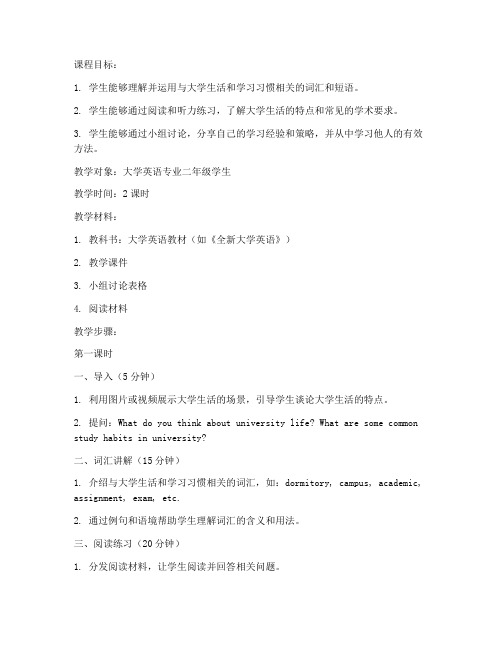
课程目标:1. 学生能够理解并运用与大学生活和学习习惯相关的词汇和短语。
2. 学生能够通过阅读和听力练习,了解大学生活的特点和常见的学术要求。
3. 学生能够通过小组讨论,分享自己的学习经验和策略,并从中学习他人的有效方法。
教学对象:大学英语专业二年级学生教学时间:2课时教学材料:1. 教科书:大学英语教材(如《全新大学英语》)2. 教学课件3. 小组讨论表格4. 阅读材料教学步骤:第一课时一、导入(5分钟)1. 利用图片或视频展示大学生活的场景,引导学生谈论大学生活的特点。
2. 提问:What do you think about university life? What are some common study habits in university?二、词汇讲解(15分钟)1. 介绍与大学生活和学习习惯相关的词汇,如:dormitory, campus, academic, assignment, exam, etc.2. 通过例句和语境帮助学生理解词汇的含义和用法。
三、阅读练习(20分钟)1. 分发阅读材料,让学生阅读并回答相关问题。
2. 教师讲解阅读材料中的难点和重点,引导学生总结文章的主要内容和观点。
四、听力练习(15分钟)1. 播放听力材料,让学生根据听力内容回答问题。
2. 教师讲解听力材料的要点,帮助学生提高听力理解能力。
第二课时一、复习(5分钟)1. 复习上一节课学过的词汇和短语。
2. 学生分享自己对大学生活和学习习惯的理解。
二、小组讨论(20分钟)1. 将学生分成小组,每个小组讨论以下问题:- What are some effective study habits you have learned?- How do you manage your time in university?- What are some challenges you face in university life?2. 每个小组选派代表分享讨论成果。
大学英语优秀教案
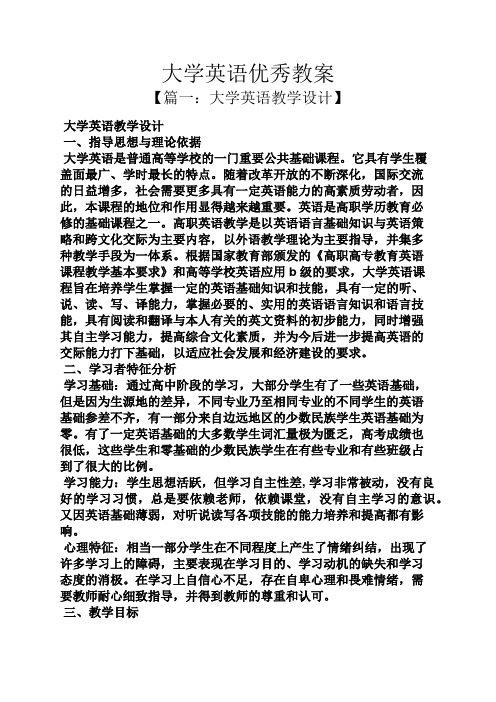
大学英语优秀教案【篇一:大学英语教学设计】大学英语教学设计一、指导思想与理论依据大学英语是普通高等学校的一门重要公共基础课程。
它具有学生覆盖面最广、学时最长的特点。
随着改革开放的不断深化,国际交流的日益增多,社会需要更多具有一定英语能力的高素质劳动者,因此,本课程的地位和作用显得越来越重要。
英语是高职学历教育必修的基础课程之一。
高职英语教学是以英语语言基础知识与英语策略和跨文化交际为主要内容,以外语教学理论为主要指导,并集多种教学手段为一体系。
根据国家教育部颁发的《高职高专教育英语课程教学基本要求》和高等学校英语应用b级的要求,大学英语课程旨在培养学生掌握一定的英语基础知识和技能,具有一定的听、说、读、写、译能力,掌握必要的、实用的英语语言知识和语言技能,具有阅读和翻译与本人有关的英文资料的初步能力,同时增强其自主学习能力,提高综合文化素质,并为今后进一步提高英语的交际能力打下基础,以适应社会发展和经济建设的要求。
二、学习者特征分析学习基础:通过高中阶段的学习,大部分学生有了一些英语基础,但是因为生源地的差异,不同专业乃至相同专业的不同学生的英语基础参差不齐,有一部分来自边远地区的少数民族学生英语基础为零。
有了一定英语基础的大多数学生词汇量极为匮乏,高考成绩也很低,这些学生和零基础的少数民族学生在有些专业和有些班级占到了很大的比例。
学习能力:学生思想活跃,但学习自主性差, 学习非常被动,没有良好的学习习惯,总是要依赖老师,依赖课堂,没有自主学习的意识。
又因英语基础薄弱,对听说读写各项技能的能力培养和提高都有影响。
心理特征:相当一部分学生在不同程度上产生了情绪纠结,出现了许多学习上的障碍,主要表现在学习目的、学习动机的缺失和学习态度的消极。
在学习上自信心不足,存在自卑心理和畏难情绪,需要教师耐心细致指导,并得到教师的尊重和认可。
三、教学目标知识目标:本课程教学既要培养学生具备必要的英语语言基础知识,具有较强的阅读能力和一定的听、说、读、写、译能力,使他们能用英语交流信息,能借助词典阅读和翻译有关英语业务资料,也应重视培养学生运用英语进行有关涉外业务工作的能力,在涉外交际的日常活动和业务活动中进行简单的口头和书面交流。
教案模板大学英语
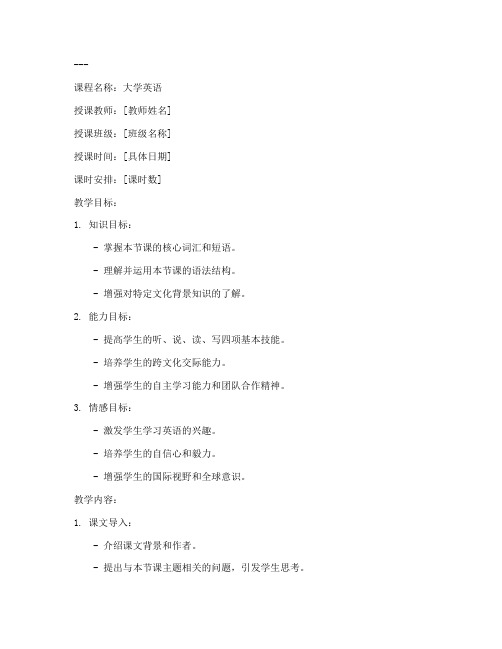
---课程名称:大学英语授课教师:[教师姓名]授课班级:[班级名称]授课时间:[具体日期]课时安排:[课时数]教学目标:1. 知识目标:- 掌握本节课的核心词汇和短语。
- 理解并运用本节课的语法结构。
- 增强对特定文化背景知识的了解。
2. 能力目标:- 提高学生的听、说、读、写四项基本技能。
- 培养学生的跨文化交际能力。
- 增强学生的自主学习能力和团队合作精神。
3. 情感目标:- 激发学生学习英语的兴趣。
- 培养学生的自信心和毅力。
- 增强学生的国际视野和全球意识。
教学内容:1. 课文导入:- 介绍课文背景和作者。
- 提出与本节课主题相关的问题,引发学生思考。
- 列出课文中的核心词汇和短语。
- 通过例句和练习,帮助学生理解和运用这些词汇。
3. 语法讲解:- 讲解本节课涉及的语法点。
- 通过例句和练习,帮助学生掌握语法结构。
4. 阅读理解:- 指导学生阅读课文,回答相关问题。
- 分析课文中的语言特点和文化内涵。
5. 口语练习:- 设计口语练习活动,如角色扮演、小组讨论等。
- 鼓励学生积极参与,提高口语表达能力。
6. 写作训练:- 提供写作任务,如写作范文、写作指导等。
- 帮助学生提高写作技巧和水平。
教学方法:1. 讲授法:讲解课文背景、词汇、语法等知识。
2. 讨论法:引导学生围绕课文主题进行讨论。
3. 练习法:通过词汇、语法、阅读、口语、写作等练习,巩固所学知识。
4. 多媒体教学法:利用多媒体资源,如PPT、视频等,丰富教学内容。
教学过程:1. 导入新课:- 用5分钟时间进行课堂导入,激发学生的学习兴趣。
- 用10分钟时间讲解课文中的核心词汇和短语,并进行练习。
3. 语法讲解:- 用10分钟时间讲解本节课的语法点,并通过例句和练习帮助学生掌握。
4. 阅读理解:- 用15分钟时间指导学生阅读课文,回答相关问题。
5. 口语练习:- 用15分钟时间进行口语练习活动,如角色扮演、小组讨论等。
6. 写作训练:- 用15分钟时间进行写作训练,提供写作任务和指导。
